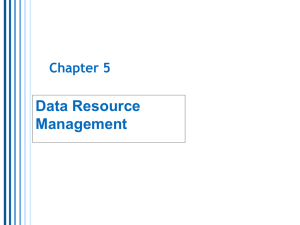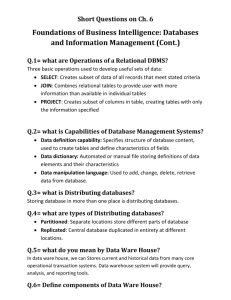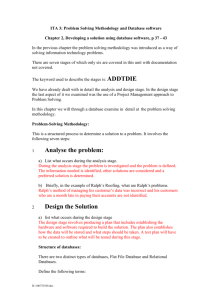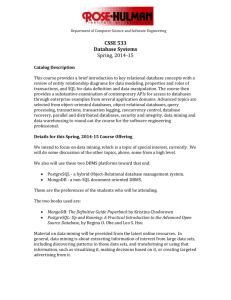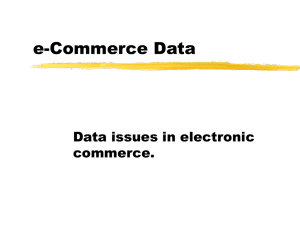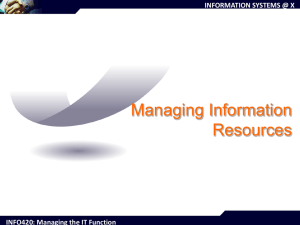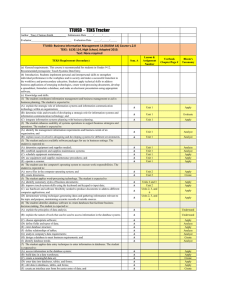PPT
advertisement
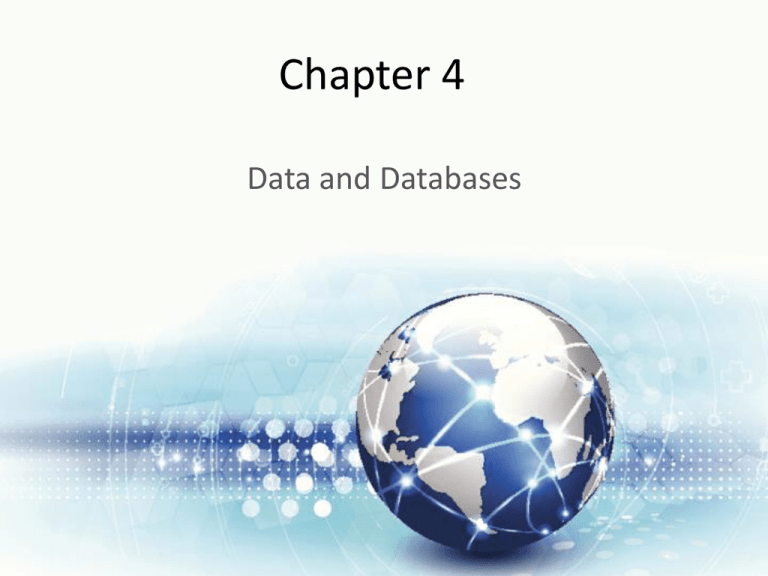
Chapter 4 Data and Databases Learning Objectives Upon successful completion of this chapter, you will be able to: • Describe the differences between data, information, and technology • Define the term database and identify the steps to creating one • Describe the role of a database management system • Describe the characteristics of a data warehouse • Define data mining and describe its role in an organization Data, Information, and Knowledge Data Information Knowledge Wisdom • Data is raw bits and pieces of information – Quantitative – numeric – Qualitative – descriptive – Alone is not useful • Information is when data is given context and more specific • Knowledge is developed when information has been aggregated and analyzed to make decisions, set policies, and spark innovation • Wisdom is the combination of knowledge and experience – May take years to develop Databases • Organized collection of related information to generate knowledge for decision making purposes – For example, a university transcript database may contain information on students, classes taken, and grades received • A separate university database would be created to maintain your financial information • Relational databases (such as Microsoft Access) where data in organized into one or more tables – Tables are a collection of fields • E.g., Student ID, Course ID, Grade Earned – Record is an instance in the table • E.g., your specific information in the table Databases continued Database Design • Design is a critical first step in creating a database – Understand the goal of how the database will be used – Identify the data needed as part of accomplishing this goal – Identify how the data is related to each other – Identify tables and fields to organize the data • Each table needs a primary key of which field(s) is unique to each record and will not change – For example, our Bronco ID • Normalization is performed to eliminate duplicated data Database Design • Each field in the database has a data type to store information: – – – – Text – non-numeric data less than 256 characters Number – numeric data Yes/No – stores 0 for No or False and 1 for Yes or True Date/Time – number data type that can be interpreted as a number or a time – Currency – monetary data – Paragraph Text – stores text longer than 256 characters – Object – data that can’t be typed such as a picture or music file • Data types dictate what functions can be performed on the data – For example, 2 number fields can be used to perform calculations • Data types indicate the amount of storage needed for each field Database Reports • Structured Query Language (SQL) is a tool/language that helps extract information from the database for analysis purposes Other Database Types • Hierarchical - parent/child relationship between data Business Classes Computer Information Systems Accounting ACC207 ACC208 CIS101 Finance CIS310 FRL300 FRL 301 • Document-centric – places data into documents that can be manipulated • NoSQL – usually on multiple machines and, in some cases, machines in multiple data centers Database Management Systems • Database Management Systems (DBMS) is an application that allows data to be: – Entered, Modified, and Deleted – Read – Reported • Has a user friendly interface to design the database • Relational databases use Microsoft Access installed on one machine with one user access at a time • Enterprise Databases serve the entire organization Data Warehouse • Consists of extracts from one or more of the organization’s databases • Allows the data to be copied and stored for analysis – Needs to be refreshed as the data changes • Data is time-stamped when extracted – Allows comparisons between different time periods • Data is standardized – All similar fields (e.g., calendar dates) are structured the same • Date is MM/DD/YYYY • Data marts are smaller subsets of data warehouses for specific business problems Data Warehouse Benefits • Forces organizations to better understand the data • Centralized view of data to identify inconsistent data • Once inconsistencies are resolved, higher quality data is used to make better business decisions • Data can be analyzed over multiple time periods • Tools are available to combine data and gain more insight into business operations Data Mining • Automated process of analyzing data – To find previously unknown trends, patterns, and associations – To make better business decisions • Starts with a hypothetical result in mind • Privacy concerns – Easier to combine disparate sources of information and when aggregated tell you much more about the individual – Data brokers now to sell this information • Business intelligence – collecting and analyzing information to increase their competitive advantage • Business analytics – uses internal company data to improve business processes and practices Knowledge Management (KM) Data Information Knowledge Wisdom • Companies and individuals accumulate knowledge • Not consistently written down or saved • If recorded, not consistently organized • KM is the process of formalizing the capture, indexing, and storing of knowledge Summary • Described the differences between data, information, and technology • Defined the term database and identify the steps to creating one • Described the role of a database management system • Described the characteristics of a data warehouse • Defined data mining and describe its role in an organization


